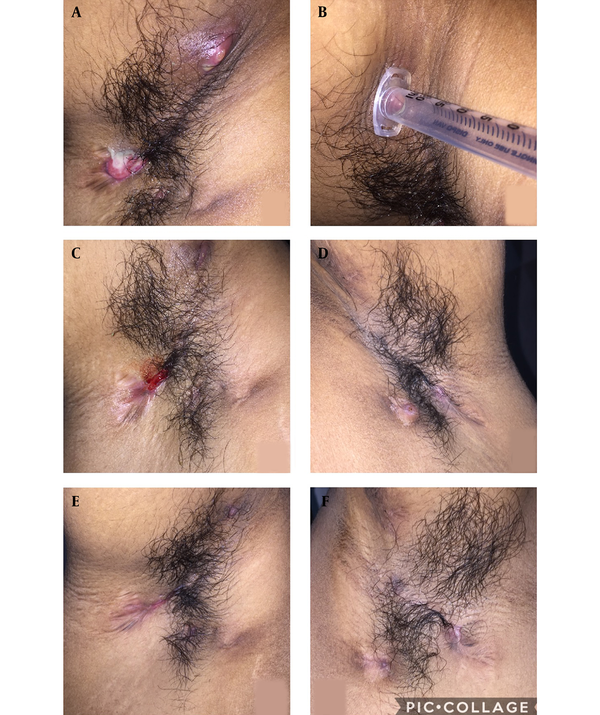Dear editor,
Hidradenitis suppurativa (HS) is a chronic inflammatory disease of apocrine glands bearing areas, which presents with suppurativa nodules, sinuses, and scars in axillae and groins. The prevalence of HS is 0.05 - 4.1% (1). Numerous treatment strategies are available for HS, such as antibiotics, retinoids, anti-androgens, immunosuppressive, anti-inflammatory agents, adalimumab (anti-tumor necrosis factor antibody), radiotherapy, surgery, and laser, but none is very satisfactory (2, 3). Combination therapy with antibiotics and hyperbaric oxygen have shown promising results (3). Sodium hypochlorite is a very good disinfectant, which has been used in food factories and hospitals for waste products sanitization on a large scale for a long time. After the emergence of COVID-19, the solution of NaOCl is more commonly used in the sanitization of clinics and hospitals for the prevention of COVID-19 infection. NaOCl works against a number of bacteria, yeasts, fungi, viruses except for spores and prions of the nose, mouth, and skin. On dilution of sodium hypochlorite, it releases nascent oxygen and chlorine, which decolonizes the above-mentioned micro-organisms. It acts by alterations in cellular metabolism, phospholipid destruction, irreversible enzymatic inactivation in microorganisms, and lipid and fatty acid degradation (4). Here, the author has used NaOCl solution in treating partially responsive stage II of HS along with antibiotics, retinoids, and zinc.
A moderately obese 18-year-old boy suffered from recurrent nodules, abscess and discharging sinuses, and scars in his both axilla for the last 1.5 years (Figure 1A). Biochemical laboratory findings were within normal range. Initially, the patient was administered rifampicin (600 mg OD), isotretinoin (20 mg OD), and zinc (2 mg/kg body weight TID) for three months along with topical metronidazole and mupirocin. The abscess is drained out by the patient with the help of an aseptic disposable syringe barrel whenever it is required (Figure 1B). The patient was followed up fortnightly for six months. At the end of the 3rd month, number and size of lesions decreased, but discharging sinuses remained patent (Figure 1C and D). After three months of the medication, topical NaOCl (0.1%) was included in the combination treatment. NaOCl was applied topically thrice a day for 1 month. The sinus tracts healed within three to four weeks (Figure 1E and F). Nodules became non-tender. Thus, this case report concludes that there is a role of bacterial infection in the chronicity of HS. NaOCl would be a good germicidal agent in treating hidradenitis suppurativa. In this combination therapy, dapsone(100 mg OD) could be added for fast resolution of inflammation and tenderness of the lesions. It is a preliminary report on the role of NaOCl in the treatment of HS. For the role of NaOCl in HS, it should be tried on a large number of Hidradenitis suppurativa patients with long-term follow-up.
A, discharging nodules and sinuses of HS in axilla; B, the abscess of the HS lesions was being drained with the help of disposable syringe barrel; C and D, partially responsive HS after three months of the treatment; E and F, healed lesions of HS after topical application of NaOCl along with oral treatment at the end of 4th month of follow-up.

